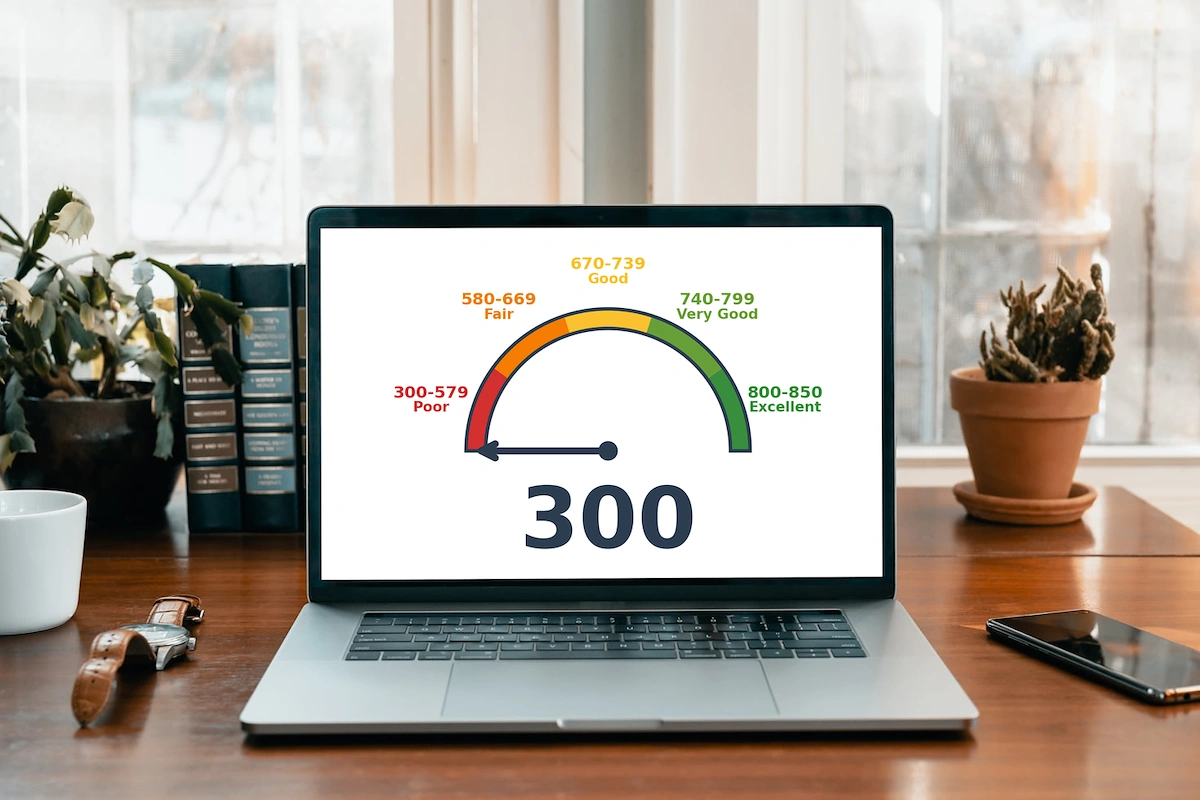
Kudos has partnered with CardRatings and Red Ventures for our coverage of credit card products. Kudos, CardRatings, and Red Ventures may receive a commission from card issuers. Kudos may receive commission from card issuers. Some of the card offers that appear on Kudos are from advertisers and may impact how and where card products appear on the site. Kudos tries to include as many card companies and offers as we are aware of, including offers from issuers that don't pay us, but we may not cover all card companies or all available card offers. You don't have to use our links, but we're grateful when you do!
300 Credit score: What You Need to Know in 2025
July 1, 2025


TL;DR
A 300 credit score represents the lowest possible starting point on the most common scoring models, offering a clear path for financial improvement. This score falls into the “Poor” FICO category, establishing a baseline from which you can begin building a stronger credit history.
What Does a 300 Credit Score Mean?
A credit score of 300 is the lowest possible score on the most common scoring models, like FICO, which range from 300 to 850. Landing at the very bottom of this spectrum places you squarely in the “poor” credit category. Lenders view this score as an indicator of extremely high risk, often stemming from a history of significant financial challenges, such as delinquencies, defaults, or bankruptcy.
This score can create major financial roadblocks. Securing new credit, whether it's a loan or a credit card, will be exceptionally difficult. Any offers you might receive will likely come with very high interest rates and unfavorable terms. While the immediate situation is challenging, a credit score is not a permanent label. It represents a snapshot in time, and understanding your position is the first step toward rebuilding your financial future.
Who Has a 300 Credit Score?
While age isn't a direct factor in credit score calculations, data shows a clear trend of scores improving over time. According to 2023 Experian data, average credit scores by generation break down as follows:
- Generation Z (ages 18-26): 680
- Millennials (ages 27-42): 690
- Generation X (ages 43-58): 709
- Baby Boomers (ages 59-77): 745
- Silent Generation (ages 78+): 760
Credit Cards With a 300 Credit Score
A credit score of 300 is the lowest possible score on most credit scoring models, signaling a significant credit risk to potential lenders. Consequently, obtaining a traditional unsecured credit card with such a score is extremely challenging, as most issuers will likely deny the application outright. While approval isn't entirely impossible, your options will likely be limited to secured credit cards that require a cash deposit as collateral.
Kudos offers AI-powered tools like the Dream Wallet, which analyzes your spending habits to provide personalized credit card recommendations tailored to your financial situation. The platform also provides insights into how applying for a new card may affect your credit score, helping you make an informed decision.
Auto Loans and a 300 Credit Score
According to 2025 Experian data, a 300 credit score places you in the deep subprime category, making an auto loan possible but extremely expensive. Lenders view this score as very high-risk, meaning you will face some of the highest interest rates available, which dramatically increases the total cost of your vehicle.
- Super-prime (781-850): 5.25% for new cars and 7.13% for used cars
- Prime (661-780): 6.87% for new cars and 9.36% for used cars
- Non-prime (601-660): 9.83% for new cars and 13.92% for used cars
- Subprime (501-600): 13.18% for new cars and 18.86% for used cars
- Deep subprime (300-500): 15.77% for new cars and 21.55% for used cars
Mortgages at a 300 Credit Score
A 300 credit score generally falls below the minimum threshold for most mortgage products. While government-backed options like FHA loans have lower requirements, they typically bottom out at a 500 score with a 10% down payment. According to mortgage requirements, very few lenders approve mortgages for scores under 600, making it highly unlikely to qualify with a 300.
If you could find a specialty lender, a 300 credit score would result in extremely high interest rates and fees. Lenders view low scores as a significant risk, so any potential loan would come with unfavorable terms. Your application would also face intense scrutiny through manual underwriting, where factors like income stability and cash reserves become even more critical for a chance at approval.
What's in a Credit Score?
Understanding your credit score can feel like trying to solve a complex puzzle, as it's a blend of several key financial habits. The most common factors that determine your score include:
- Your payment history tracks whether you have paid past credit accounts on time.
- Credit utilization is the percentage of your available credit that you are currently using.
- The length of your credit history considers the age of your oldest account and the average age of all your accounts.
- Credit mix refers to the variety of credit products you have, such as credit cards, retail accounts, and loans.
- New credit inquiries and recently opened accounts can also temporarily impact your score.
How to Improve Your 300 Credit Score
Even with a 300 credit score, which is the lowest possible FICO® score, it is entirely possible to rebuild your financial standing. There are several proven methods you can use to start improving your credit today.
- Apply for a secured credit card. Since these cards require a security deposit, they are accessible to people with poor credit. Making timely payments will be reported to the credit bureaus, helping you establish a positive payment history.
- Become an authorized user. By being added to the account of a responsible cardholder, their positive payment history and low credit utilization can be added to your credit file. This can provide a helpful boost to your score without requiring a new application.
- Consider a credit-builder loan. These small loans are designed specifically to help individuals establish or rebuild credit. Your on-time payments are reported to the credit bureaus, which diversifies your credit mix and demonstrates financial responsibility.
- Address collection accounts. If you have accounts in collections, negotiating a settlement or requesting a goodwill deletion can remove a significant negative item from your report. Resolving these derogatory marks is a critical step toward repairing a very low score.
To help manage your cards, maximize rewards, and monitor your score as it improves, a tool like Kudos can be an invaluable financial companion.

Supercharge Your Credit Cards
Experience smarter spending with Kudos and unlock more from your credit cards. Earn $20.00 when you sign up for Kudos with "GET20" and make an eligible Kudos Boost purchase.
Editorial Disclosure: Opinions expressed here are those of Kudos alone, not those of any bank, credit card issuer, hotel, airline, or other entity. This content has not been reviewed, approved or otherwise endorsed by any of the entities included within the post.




























.webp)
.webp)
.webp)
%20(1).webp)
.webp)


.webp)
.webp)
%20(1).webp)